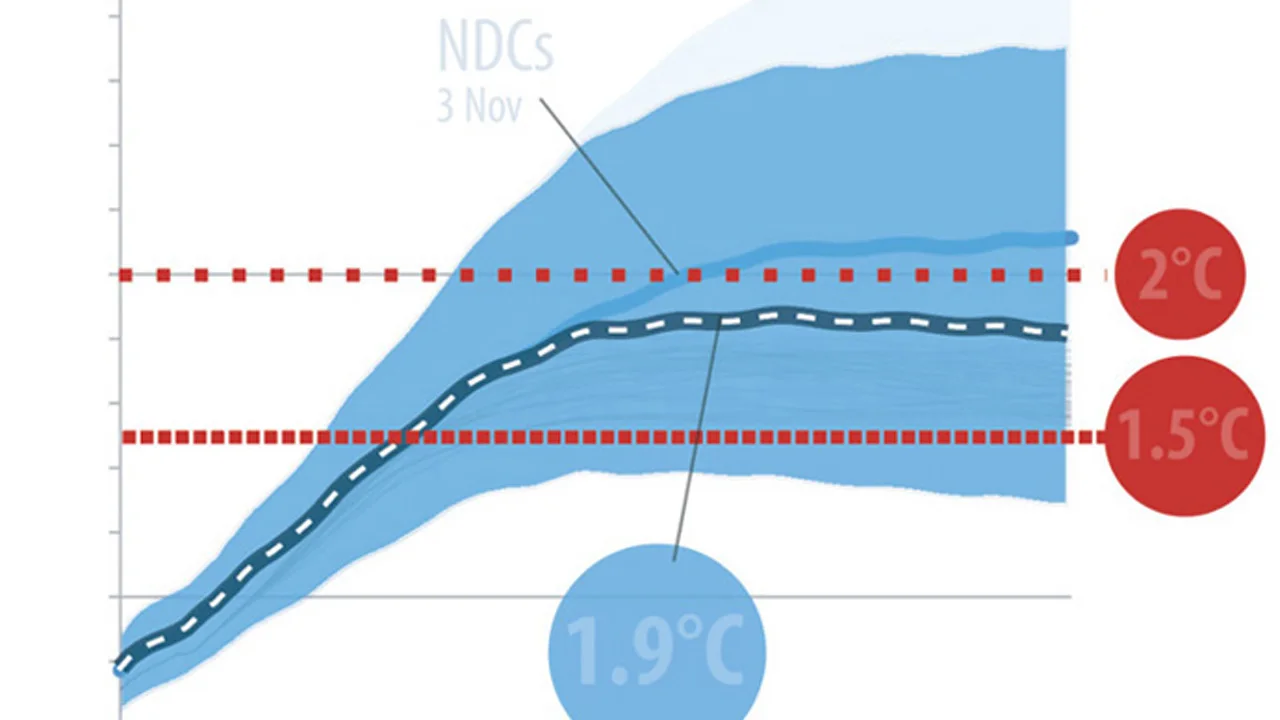
COP26 pledges represent historic reduction in projected global warming
In a first for UN climate summits, commitments made by world leaders actually have a good chance of limiting global warming to less than 2°C, however they now need to follow through on those pledges.
Based on the latest assessment of the commitments made at the United Nations COP26 climate summit, the world can now meet the broader 2°C target of the Paris Agreement. In addition, we have also drawn even closer to the more ambitious goal of limiting global warming to just 1.5°C above pre-industrial temperatures.
In the days leading up to the UN's COP26 conference in Glasgow, two reports were issued, neither of which painted a very glowing picture of the future. The WMO's Greenhouse Gas Bulletin and the UNEP's Emissions Gap Report 2021 basically said that the world was way off track to meet the targets of the 2015 Paris Agreement. Based on the assessments in these reports, the commitments made by those countries that had submitted their Nationally Determined Contributions (NDCs) before the conference were simply not enough. Even if they were all implemented as stated and on schedule, global warming would still cause temperatures to reach 2.7°C above pre-industrial times.
"We are way off track," Professor Petteri Taalas, the Secretary-General of the WMO, said in a press release.
"The Greenhouse Gas Bulletin contains a stark, scientific message for climate change negotiators at COP26. At the current rate of increase in greenhouse gas concentrations, we will see a temperature increase by the end of this century far in excess of the Paris Agreement targets of 1.5 to 2 degrees Celsius above pre-industrial levels," Taalas added.
During the first week of the summit, more nations added their own commitments. A flurry of new 'net-zero' pledges were also made, as countries set hard dates on when they would stop emitting greenhouse gases into the atmosphere. While emissions would likely continue after these 'net-zero' dates, technologies or programs would be implemented to capture those emissions or offset them.
As a result of all this, a new Climate Resource report released on November 3 said that, for the first time in the history of these climate summits, the COP26 pledges have reduced projected warming below 2°C.

How it started vs how it's going for COP26 shows that while the best-case scenario for warming with the NDCs pledged pre-conference would not meet the goals of the Paris Agreement, as of November 3, new pledges managed to bring projected warming down to below 2°C. Credit: Climate Resource
In fact, their projections now show that if all nations abide by their commitments and stay on schedule, we may actually be able to limit global warming to below 2°C. This is the very first time that an assessment of one of these climate summits has actually accomplished that goal!
According to Climate Resource's modelling, directly based on these new commitments, global temperatures will reach a maximum of 1.9°C sometime in the 2060s. Also, with emissions continuing to fall afterward, temperatures would actually show a modest cooling trend, falling to just +1.8°C by the end of the century.
"This is still a far stretch from halting warming around 1.5°C," the report states, "but substantially improved over projections from just a few weeks ago."
The conditions for this — that nations show continued support for their stated commitments and implement these commitments on schedule — are critically important. Governments must now follow through on their commitments with new, more robust climate policies, and they have to act upon those policies.
"It's easy to pledge to do something in 30 to 50 years," Dr. Zeke Hausfather, Director of Climate and Energy for The Breakthrough Institute, said on Twitter, "the real test is the extent to which they are reflected in enhanced near-term ambition, and in that department results are mixed given the relatively modest updates to many countries 2030 NDCs."
Also, it should be noted that the Climate Resource projections include some significant uncertainties — some from the climate system itself, while others come from emission pathways after 2030. The 1.9°C maximum and 1.8°C by the end of the century are the averages of their modelling runs. Based on the uncertainties, the temperature rise could be limited to as low as 1.4°C, with it cooling to 1.3°C by 2100. On the other hand, temperatures could continue to rise to around 2.7°C by the end of the century. The majority of their scenarios (63 per cent) keep temperatures to less than 2 degrees, while only 11 per cent manage to restrict warming to 1.5 degrees or less.

This comparison of emissions and warming projections, based on the COP26 commitments so far, is accompanied by a critical warning label. Credit: Climate Resource
WHY IS THIS IMPORTANT?
When world leaders first met at COP21 in December 2015 — the summit which led to the establishment of the Paris Agreement — their stated goal was to limit global warming to only 2°C above pre-industrial temperatures. This was just weeks ahead of NOAA and NASA declaring 2015 as the warmest year on record to date. The global average temperature that year reached 1.1°C above the pre-industrial average from 1880–1900. 2016 went on to break that record, at close to 1.2°C above pre-industrial.
It was during the conference that a more ambitious (and necessary) target was set, to limit that warming to just 1.5°C. This new goal was based on the scientific consensus that the impacts of climate change would be far less severe at 1.5°C than they would be at 2°C. Also, by limiting temperature rise to just 1.5°C, Pacific island nations such as Tuvalu — a group of reef islands and atolls located about halfway between Australia and Hawaii — could be saved from disappearing under rising ocean waters.

The Funafuti atoll, the capital of the island nation of Tuvalu, is very vulnerable to sea level rise. Credit: Gabriella Jacobi/Wikimedia Commons (CC by 3.0)
A 2018 IPCC special report analyzed the feasibility and impacts of limiting global warming to just 1.5°C. It found that it was not only possible to reach that goal, even now, but it would be necessary to avoid devastating climate impacts.
As stated in the IPCC press release for the report: "For instance, by 2100, global sea level rise would be 10 cm lower with global warming of 1.5°C compared with 2°C. The likelihood of an Arctic Ocean free of sea ice in summer would be once per century with global warming of 1.5°C, compared with at least once per decade with 2°C. Coral reefs would decline by 70–90 per cent with global warming of 1.5°C, whereas virtually all (> 99 per cent) would be lost with 2ºC."
"Every extra bit of warming matters, especially since warming of 1.5°C or higher increases the risk associated with long-lasting or irreversible changes, such as the loss of some ecosystems," Hans-Otto Pörtner, one of the report's lead authors, said in the statement.











